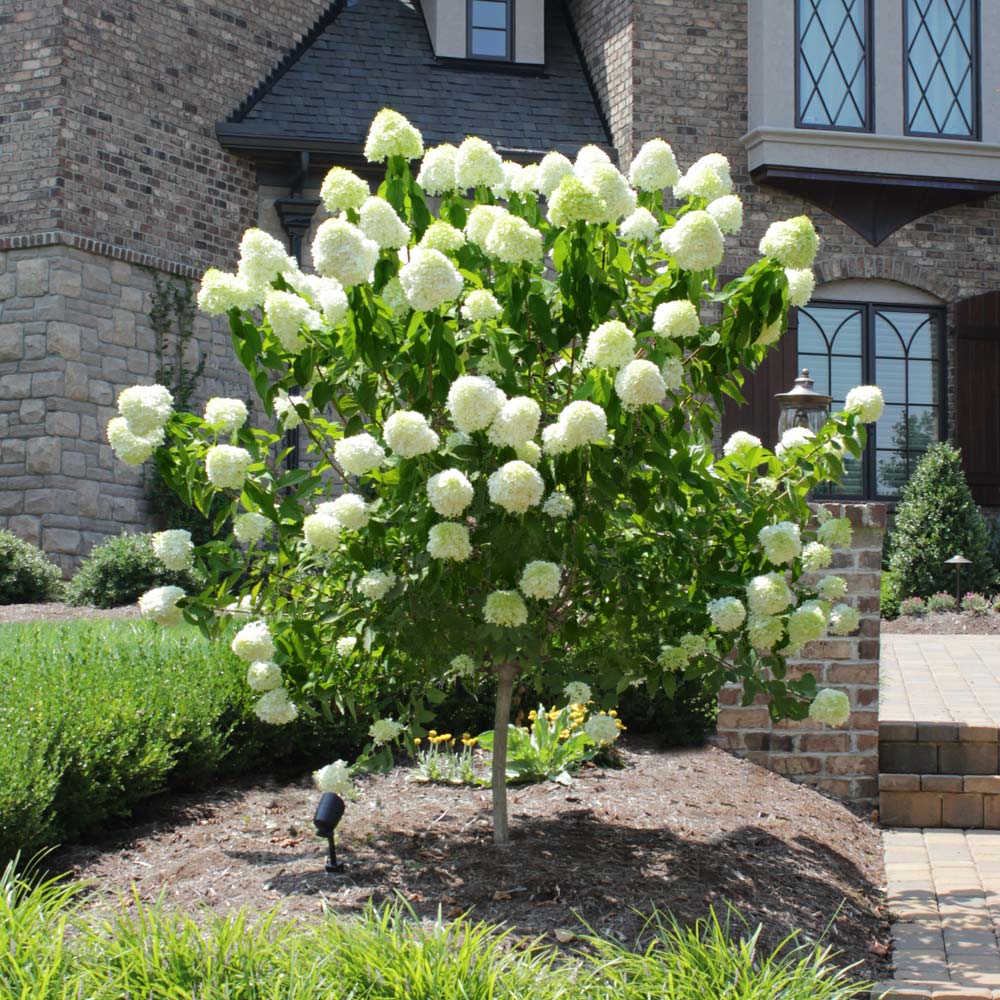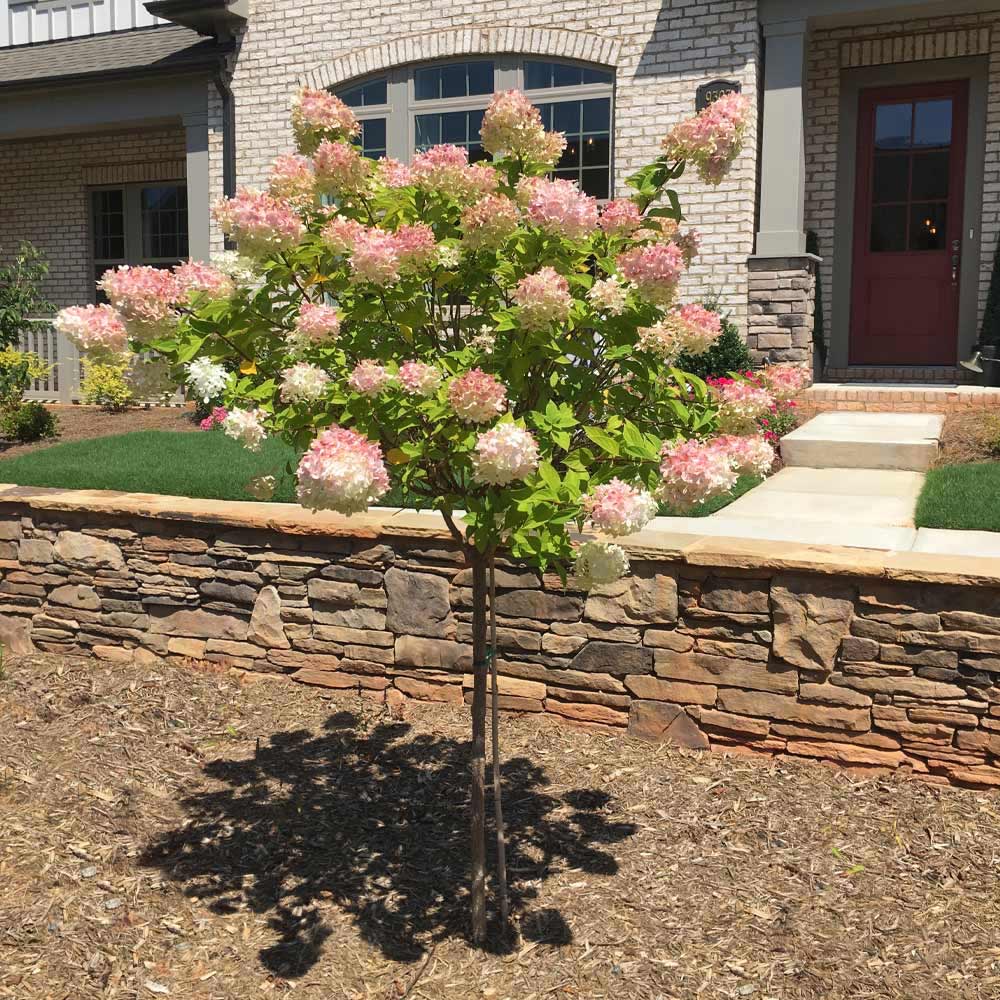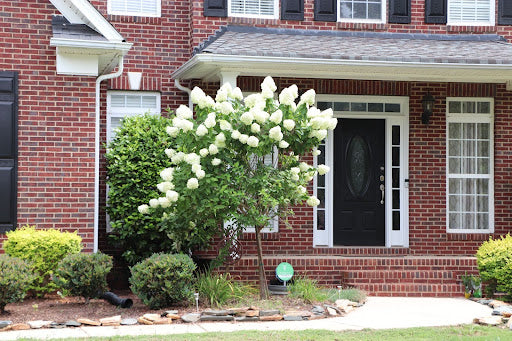Hydrangea Trees
Sorts and Filters
Collection Results


Limelight Hydrangea Tree
125 reviewsStarting at $134.95BUY 1, GET 1 50% OFF
Vanilla Strawberry™ Hydrangea Tree
83 reviewsStarting at $229.95Up to 14% OFF
Little Lime® Hydrangea Tree
28 reviewsStarting at $74.95Up to 42% OFF
First Editions® Eclipse® Bigleaf Hydrangea
1 reviewsSold Out
Cityline® Paris Bigleaf Hydrangea
1 reviewsSold Out
Endless Summer® Twist-n-Shout® Hydrangea
Sold Out
Fire Light® Hydrangea Tree
7 reviewsSold Out
Hydrangea trees, also known as Hydrangea paniculata, are among the most stunning flowering trees available, and it’s easy to see why. They grow in most parts of the United States, offer large, vibrant flowers, and are dependable bloomers year after year.
Hydrangea are shrubs that don’t naturally grow in tree form. However, Hydrangea paniculata can be trained to take a tree shape with careful pruning.
Learn more about the three types of hydrangeas in our complete guide.
Hydrangea Trees Varieties
There are dozens of hydrangea tree varieties, each with the same show-stopping blooms. A few of our favorites are below.
Fire Light Hydrangea Tree: Enjoy blazing creamy white and red-pink blooms for months with a Fire Light Hydrangea. Fire Light hydrangeas make a fantastic specimen plant and are a favorite choice for cut flower arrangements and dried flowers.
1. Hardiness: USDA zones 3 to 8
2. Size: 6 feet tall x 6 feet wide
3. Growth rate: Moderate
4. Sunlight:Full sun to Partial Sun
5. What makes Fire Light Hydrangea unique:
Limelight Hydrangea Tree: This extremely cold-hardy hydrangea tree is reminiscent of an eloquent bouquet. You’ll be awed by the enormous poms of white blooms that emerged from this petite variety.
1. Hardiness: USDA zones 3 to 8
2. Size: 6-8 feet tall x 4-5 feet wide
3. Growth rate: Moderate
4. Sunlight:
5. What makes Fire Light Hydrangea unique:
Little Lime Hydrangea Tree: All the benefits of a Limelight Hydrangea in a dwarf tree form. This stunning hydrangea is easy to manage, making it perfect for tight borders and patio and porch containers.
1. Hardiness: USDA zones 3 to 9
2. Size: 3-5 feet tall x 3-5 feet wide
3. Growth rate: Moderate
4. Sunlight:
5. What makes Fire Light Hydrangea unique:
Vanilla Strawberry Hydrangea Tree: Like a sweet dessert for your garden, Vanilla Strawberry Hydrangea blooms start creamy white and turn to an irresistible pink before transitioning to deep red and burgundy. Because this gorgeous tree blooms throughout spring and summer, it has a rainbow of colors all at once.
1. Hardiness: USDA zones 4 to 8
2. Size: 6-8 feet tall x 4-5 feet wide
3. Growth rate: Fast
4. Sunlight:Full sun
5. What makes Fire Light Hydrangea unique:
If you’re on the hunt for a hydrangea tree for sale, check out our collection.
Hydrangea Tree Maintenance
Hydrangea trees are easy to care for as long as a few basic requirements are met.
Temperature and humidity: Hydrangeas can grow in a wide range of climates. They are hardy in USDA zones 4 through 8, which encompasses the majority of mainland America. This plant wouldn’t thrive in extreme heat or cold.
When to plant: Target springtime after the last frost and early fall.
Sunlight: Plant your hydrangea tree in a spot that receives at least 4 hours of sunlight daily in the spring and summer. Hydrangea trees can survive in full sun, but their blooms won’t last as long.
Soil: Hydrangea trees do best in organically rich, well-draining soil with a neutral to slightly acidic pH. They can handle other soil types, as well, such as sandy, loamy, and even clay, but they might not reach their full potential.
Water: Panicle Hydrangeas prefer moist but not soggy soil. Be careful not to overwater them. Yellowing leaves can be a sign of excess irrigation. It’s essential to water tree hydrangeas during dry spells, windy days, and abnormal heat.
Fertilizer: Tree hydrangeas don't need fertilizer, but feeding will help encourage new wood growth. Aim for early spring. Use a balanced fertilizer for shrubs.
Pruning: Hydrangea trees bloom on new wood, so be vigilant when pruning, or you’ll cut off flower buds. Prune your hydrangeas tree in late fall or early winter. You can also leave dried flower heads through the winter for visual interest and prune in the very early spring before new wood has time to grow. Make sure to remove sucker shoots.
Common problems: Keep a close eye on your hydrangea trees. They are susceptible to aphids looking to feast on new growth in the summer and powdery mildew.
Pests and diseases: Keep a close eye on your hydrangea trees. They are susceptible to aphids, spider mites, and vine weevils. They’re also known to catch powdery mildew.
Animals: Are tree hydrangeas toxic? Yes—they are harmful to animals and humans. Plant them with care.
Common Questions About Hydrangea Trees
How big do hydrangea trees get?
Most hydrangea trees can reach heights of 6-8 feet, but several dwarf varieties, like the Little Lime Hydrangea Tree max out at 3-5 feet tall.
When do hydrangea trees bloom?
Specific timing for your hydrangea blooms will vary depending on your growing zone’s climate, but most trees will begin blooming in April.
How fast do hydrangea trees grow?
Hydrangeas boast a moderate growth rate. If you’re interested in bigger blooms gracing your yard as soon as possible, we suggest ordering one of our larger sizes.
How long do hydrangea trees bloom?
Hydrangeas begin blooming in the spring and continue their beautiful blooms through the summer. Different varieties will have varying blooming times, but we love the Endless Summer variety for its long blooming season.
More Hydrangea Trees Resources
Caring for Hydrangeas: Our Top 4 Tips for Success
Plant Care 101: Limelight Hydrangea Tree